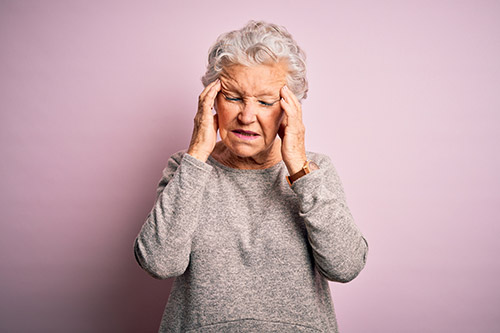
Hello dear residents, resident’s family, and the entire local community who are struggling through providing in-home assisted living or memory care services. This goes out to you whether you are or are not actively searching for professional assisted living or memory care services in and around Ellijay. Those of you who follow our assisted living and memory care blog know that we invest in all of you by offering the lessons learned of our entire highly trained, skilled, and loving staff.
Everyone needs to be aware of the signs of stroke and know exactly what to do when these signs appear. Americans suffer strokes at a rate of one every 40 seconds, according to the Centers for Disease Control and Prevention. Nearly 75 percent of strokes occur in people aged 65 or older. However, age-related risk begins around age 55, and a stroke can happen at any age.
Strokes are categorized by their causes:
- Nearly 87% of strokes are ischemic strokes, which are caused by blood clots or plaques that block blood vessels to the brain.
- When a blood vessel in the brain bursts, damaging surrounding tissues, this is called a hemorrhagic stroke.
- A mini-stroke or transient ischemic attack (TIA) is a stroke that lasts fewer than five minutes but still blocks blood flow to the brain. Such mini-strokes may also be a warning sign for future strokes.
During a stroke, brain cells can quickly become damaged. This is due to a lack of oxygen. Symptoms may first develop in parts of the body which are controlled by those damaged areas.
Understanding Stroke Risks
One’s lifestyle choices, health conditions, and family history can increase a person’s risk of stroke. Although some of these risk factors may be outside of your control, the CDC estimates that up to 80 percent of strokes may be prevented through lifestyle changes alone.
Health Conditions
Conditions such as heart disease, high blood pressure, high cholesterol, obesity, and diabetes may increase one’s risk of stroke. The chances of having a stroke are also higher for those who have already experienced a stroke or TIA.
Lifestyle Factors and Behaviors
Lifestyle and behavior factors that increase the risk of stroke are similar to those that increase one’s risk for heart disease. This includes physical inactivity, smoking tobacco, and drinking excessive amounts of alcohol. Nutritional factors are also a concern, as eating a diet high in cholesterol, sodium, and saturated fats can also increase a person’s risk of stroke.
Family History and Genetics
A stroke can occur at any age. However, after age 55, a person’s chance of stroke doubles nearly every decade. Strokes occur more frequently in women than men, and race or ethnicity — especially for Black, Hispanic, American Indian, and Alaska Native individuals — may heighten stroke risk as well. One’s family stroke history and certain genetic disorders such as sickle cell disease may also increase risk. Knowing your family’s history of stroke may help you take preventative actions earlier on.
5 Common Indicators of Stroke
Become more familiar with these five common stroke indicators and empower yourself to save your own life – or the life of someone near you.
- Sudden weakness or numbness in the face, arm, or leg. The sensation may be contained to only one side of your body.
- Difficult speaking or trouble understanding speech. One may also experience a sudden sense of confusion or disorientation.
- Vision loss which comes on unexpectedly. This may occur in one or both eyes.
- Trouble walking, unexplained dizziness, or loss of balance or coordination. This symptom, too, can manifest quite quickly.
- Severe headache or brief loss of consciousness.
If you or someone near you experiences any of these signs, call 911 immediately. Medical professionals will need to make an assessment and begin treatment as needed.
Remember that fast, professional treatment is key for ensuring the best outcomes in the event of a stroke. Do not drive yourself or someone else to the hospital who may be experiencing a stroke. Your best course of action to treat yourself or the person with you is to dial 911 and request an ambulance.
Act “F.A.S.T.” to Assess a Stroke
Every minute counts when it comes to a stroke. This easy to remember assessment from the American Stroke Association can help you determine if you (or a person near you) is experiencing a stroke. Most successful stroke treatment occurs within the first three hours after symptom onset. Commit the stroke acronym F.A.S.T. to your memory. It could help save a life.
- F — Face Drooping
Do you notice a drooping in the person’s face? Ask the person to smile. Does one side of the face feel numb or droopy or does the smile appear lopsided? - A — Arm Weakness
Ask the person to lift both arms up. When they do, do they indicate that one arm feels numb? Does the arm drift downward? - S — Speech Difficulty
Ask the person to repeat a simple sentence such as stating their name and address. Do they have difficulty repeating this sentence? Is their speech slurred? - T — Time to Call 911
If the person displays any of these symptoms, call 911 to get them professional treatment immediately.
We hope you benefit, are encouraged, educated, and enjoy our blogging efforts. When the time comes for you to seek a consult regarding caring for your loved one’s professional assisted living or professional memory care services, please know that Manor Lake Assisted Living & Memory Care in Ellijay stands ready to improve the quality of both you and your loved one’s lives. Call us!
